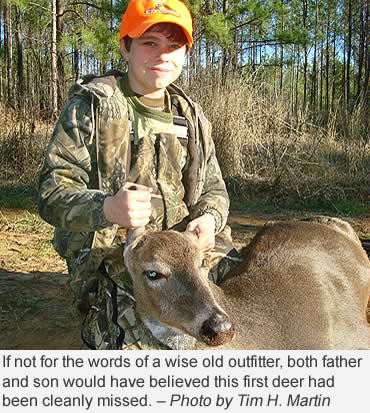By Tim H. Martin
We all know the telltale signs of a deer being hit with a bullet. The obvious reactions are a hunching of the back, a bronco-like kick, stumbling, and a changing of the deer’s gait or even the animal being completely knocked down. But one important sign is much more subtle.
While hunting with an outfitter in Ohio several autumns ago, I learned this valuable lesson.
One of the other hunters and his guide came trudging in late from an evening hunt looking mighty dejected. The owner of the operation, along with myself and three other hunters were just finishing dinner when the men told their sad tale.
The guide said, “It was a MONSTER. I thought he made a good shot, but we didn’t find any hair, or even a single drop of blood. The deer didn’t flinch, but just clamped his tail and ran off like a scalded dog. I’m sure it was a clean miss.”
The owner — an older and very experienced hunter — said, “Wait, did you say it clamped its tail?” The hunter and guide both nodded yes.
“Let’s go! That’s a dead deer,” the owner said.
We grabbed flashlights and returned to the place the deer was last seen. Five minutes into the search, the guide yelled, “Found it!” Although the 190-inch buck gave no other sign of being mortally wounded, it had died 50 yards from the field’s edge.
Fast forward two hunting seasons.
My 10-year-old son and I were hunting in Alabama, trying to get the boy his first deer.
The whitetails were in full rut and had been moving all day. As luck would have it, I spotted a big doe trotting our direction as we hiked to our double ladder stand.
We knelt quickly, and I handed my son the .243, whispering to him that I would stop the doe when it got closer.
 As the old nanny entered an opening at 40 yards, I bleated with my voice, stopping it in its tracks.
As the old nanny entered an opening at 40 yards, I bleated with my voice, stopping it in its tracks.
Graham removed the safety, aimed steadily and shot without hesitation.
The doe did an about face, galloping away like a racehorse out of the gate, then leapt a fallen pine effortlessly. It never flinched or showed any sign of being hit.
Still, for 40 minutes, we scoured the area for blood, hair, or any sign of a hit. There was nothing.
Since we were close to the ladder stand, I decided to set up in the hope that other deer would enter the field later despite our commotion.
As we settled in, I glanced toward my son and saw tears streaming down his cheeks. He was heartbroken about the miss. So was I.
Then, I replayed the shot in my mind several times and suddenly remembered the doe had clamped her tail. The old outfitter’s words came back to me: “Let’s go! That’s a dead deer.”
We got down from the stand and returned to the last place we’d seen the doe. I pushed and crawled through dense undergrowth and was delighted to spy the white underbelly of my son’s first deer another 50 yards farther into the woods.
It was a perfect quartering lung shot, but the bullet never exited, and the deer simply never bled or made any of the indications deer normally make when hit hard.
Although there was no blood trail, stumbling or other signs of a hit, that one telltale sign about a clamped tail made the difference between tears of sadness and tears of joy.
Read Recent Tip of the Week:
• Bowhunting Practice: So, you’re accurate with your bow out to 50 yards. How about with all your hunting clothes on … from elevation … at weird angles … at dawn?